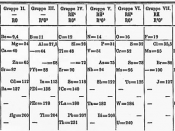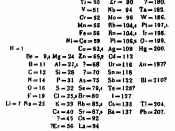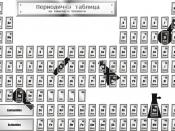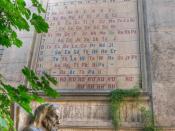Adam Sahs
Period 1
October 1, 2008
Scientist
Dmitri Mendeleev
Mendeleev is best known as the chemist who created the periodic table of elements. He arranged the 63 elements known at the time into a Periodic Table based on atomic mass. This was then published in Principles of Chemistry in 1869. His first Periodic Table was put together by arranging the elements in ascending order of atomic weight and grouping them by the similarity of properties. He even predicted that other elements existed, and left space open for them. Mendeleev also provided for variance of atomic weight order, and he predicted three yet to be discovered elements including silicon and boron. However, his table did not include any of the Noble Gases since they had not yet been discovered.
Dmitri Mendeleev was born February 8, 1834 in Tobolsk, Siberia. Mendeleev's mother was Maria Dmitrievna Kornileva; his father was Ivan Pavlovich Mendeleev.
Mendeleev was the youngest of about 11 to 17 siblings. He died on Saturday, February 2, 1907, at age seventy-two in St. Petersburg, Russia. The cause of his death was determined to be influenza. If he had lived a few more years, he would have witnessed the complete development of his periodic table by Henry Moseley.
Mendeleev's mother took him to St. Petersburg, where he enrolled in the Main Pedagogical Institute and graduated in 1855. He got his first teaching position at Simferopol in Crimea. He stayed there only two months and decided to go back to St. Petersburg to continue his education. He received a master's degree in 1856 and began to conduct research in organic chemistry. Financed by a government fellowship, he went to study abroad for two years at the University of Heidelberg, where he set up a laboratory in his own apartment. In 1861 Mendeleyev returned to St. Petersburg, where he obtained a professorship at the Technological Institute in 1864. After the defense of his doctoral dissertation in 1865 he was appointed professor of chemical technology at the University of St. Petersburg. He became professor of general chemistry in 1867 and continued to teach there until 1890.
Dmitri Mendeleev's achievement contributes to my study of chemistry in that he has given me an invaluable organization tool. He has given us a list of the elements. The periodic table tells me whether the element is a metal, nonmetal, or metalloid. The table also tells which elements have similar properties. Using the atomic number and mass number you can also easily find the number of protons, electrons, and neutrons in that element. Without the periodic table of elements at my disposal I would be essentially lost when trying to break down the structure of an element. I would have no guide as to where to go or what to do next.
Bibliography:
Bridgewater, William, and Seymour Kurtz, eds. "Mendeleyev, Dmitri." The Illustrated Columbia Encyclopedia. 3rd ed. 1956. 4001-4005.
Morse, Joseph L., and William H. Hendelson, eds. "Mendeleev, Dmitri Ivanovich." Funk & Wagnalls New Encyclopedia. 1st ed. Vol. 16. New York, NY: Funk & Wagnalls, Inc., 1969. 173-79.
�





